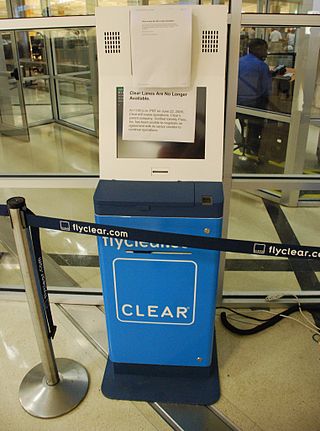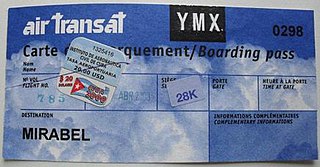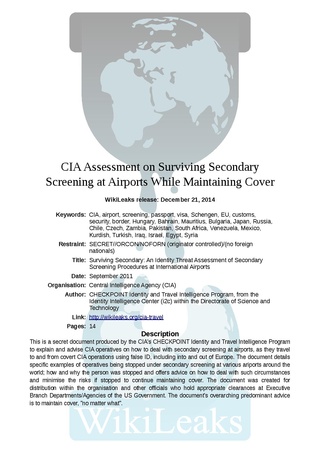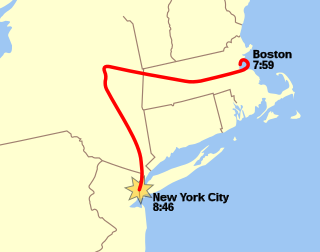Aircraft hijacking is the unlawful seizure of an aircraft by an individual or a group. Dating from the earliest of hijackings, most cases involve the pilot being forced to fly according to the hijacker's demands. There have also been incidents where the hijackers have overpowered the flight crew, made unauthorized entry into the cockpit and flown them into buildings – most notably in the September 11 attacks – and in several cases, planes have been hijacked by the official pilot or co-pilot; e.g., Ethiopian Airlines Flight 702.

The Transportation Security Administration (TSA) is an agency of the United States Department of Homeland Security (DHS) that has authority over the security of transportation systems within, and connecting to the United States. It was created as a response to the September 11 attacks to improve airport security procedures and consolidate air travel security under a combined federal law enforcement and regulatory agency.

Richard Colvin Reid, also known as the Shoe Bomber, is the perpetrator of the failed shoe bombing attempt on a transatlantic flight in 2001. Born to a father who was a career criminal, Reid converted to Islam as a young man in prison after years as a petty criminal. Later he became radicalized and went to Pakistan and Afghanistan, where he trained and became a member of al-Qaeda.

Air France Flight 8969 was an Air France flight that was hijacked on 24 December 1994 by the Armed Islamic Group of Algeria (GIA) at Houari Boumediene Airport, Algiers. The terrorists murdered three passengers and their intention was either to detonate the aircraft over the Eiffel Tower or the Tour Montparnasse in Paris. When the aircraft reached Marseille, the National Gendarmerie Intervention Group (GIGN), a counter-terror unit of the French National Gendarmerie, stormed the plane and killed all four hijackers.

Airport security includes the techniques and methods used in an attempt to protect passengers, staff, aircraft, and airport property from malicious harm, crime, terrorism, and other threats.

On December 22, 2001, a failed shoe bombing attempt occurred aboard American Airlines Flight 63. The aircraft, a Boeing 767-300ER with 197 passengers and crew aboard, was flying from Charles de Gaulle Airport in Paris, France, to Miami International Airport in the U.S. state of Florida.
The Computer-Assisted Passenger Prescreening System (CAPPS) is a counter-terrorism system in place in the United States air travel industry that matches passenger information with other data sources. The United States Transportation Security Administration (TSA) maintains a watchlist, pursuant to 49 USC § 114 (h)(2), of "individuals known to pose, or suspected of posing, a risk of air piracy or terrorism or a threat to airline or passenger safety." The list is used to pre-emptively identify terrorists attempting to buy airline tickets or board aircraft traveling in the United States, and to mitigate perceived threats.
The No Fly List, maintained by the United States federal government's Terrorist Screening Center (TSC), is one of several lists included in algorithmic rulesets used by government agencies and airlines to decide who to allow to board airline flights. The TSC's No Fly List is a list of people who are prohibited from boarding commercial aircraft for travel within, into, or out of the United States. This list has also been used to divert aircraft away from U.S. airspace that do not have start- or end-point destinations within the United States. The number of people on the list rises and falls according to threat and intelligence reporting. There were reportedly 16,000 names on the list in 2011, 21,000 in 2012, and 47,000 in 2013.

A registered traveler is a person qualified through an airline passenger security assessment system in the United States air travel industry. Such programs were initially tested in 2005. Registered traveler programs are currently in operation in various airports around the country and are administered by TTAC, the Transportation Security Administration (TSA) office responsible for Secure Flight, the replacement for the Computer Assisted Passenger Prescreening System (CAPPS) and the canceled CAPPS II counter-terrorism system.
Security theater is the practice of implementing security measures that are considered to provide the feeling of improved security while doing little or nothing to achieve it.

A boarding pass or boarding card is a document provided by an airline during airport check-in, giving a passenger permission to enter the restricted area of an airport and to board the airplane for a particular flight. At a minimum, it identifies the passenger, the flight number, the date, and scheduled time for departure. A boarding pass may also indicate details of the perks a passenger is entitled to and is thus presented at the entrance of such facilities to show eligibility.
Secure Flight is an airline passenger pre-screening program, implemented from August 2009 by the United States Transportation Security Administration (TSA). Secure Flight matches passenger information against watch lists maintained by the federal government. The initial implementation phase of Secure Flight resulted in the complete transfer of responsibility for passenger watch list matching to TSA from aircraft operators whose flights operate within the United States. The second phase of Secure Flight will result in the transfer of responsibility for passenger watch list matching to TSA for flights into, out of, and over the United States.

Secondary Security Screening Selection or Secondary Security Screening Selectee, known by its initials SSSS, is an airport security measure in the United States which selects passengers for additional inspection. People from certain countries are subject to it by default. The passengers may be known as Selectee, Automatic Selectee or the Selectee list. The size and contents of the list fluctuates and is a secret, although the Transportation Security Administration has stated there are tens of thousands of names on it.
Passenger Protect, commonly referred to as the Canadian no-fly list, is the Canadian government initiative to identify individuals who may be an "immediate threat to aviation security" and prevent them from boarding a flight.

American Airlines Flight 11 was a domestic passenger flight that was hijacked by five al-Qaeda terrorists on the morning of September 11, 2001, as part of the September 11 attacks. The hijacked airliner was deliberately crashed into the North Tower of the World Trade Center complex in New York City, killing everyone aboard the flight and resulting in the deaths of more than one thousand people in the top 18 stories of the skyscraper in addition to causing the demise of numerous others below the trapped floors, making it not only the deadliest of the four suicide attacks executed that morning in terms of both plane and ground fatalities, but also the single deadliest act of terrorism in human history and the deadliest plane crash of all time. The aircraft involved, a Boeing 767-223ER with 92 passengers and crew, was flying American Airlines' daily scheduled morning transcontinental service from Boston Logan International Airport in Massachusetts to Los Angeles International Airport in California.
In the United States, border security includes the protection of ports, airports, and the country's 3,017-mile (4,855 km) land border with Canada and 1,933-mile (3,111 km) border with Mexico. The U.S. concept of border security is deeply entwined with the persistent actual or perceived threat of terrorism, as well as more universal concerns such as immigration control, smuggling, and human trafficking. As such, the U.S. federal government is constantly reevaluating and adjusting its border security policies to reflect the perceived threats posed to the United States.
The United States has an extensive air transportation network. In 2013, there were 86 airports in the U.S. that annually handled over 1,000,000 passengers each. The civil airline industry is entirely privately owned and has been largely deregulated since 1978, while most major airports are publicly owned. The three largest airlines in the world by passengers carried are U.S.-based; American Airlines is number one after its 2013 acquisition by US Airways. Of the world's 50 busiest passenger airports, 16 are in the United States, including the top five and the busiest, Hartsfield–Jackson Atlanta International Airport. In terms of cargo, in 2015, eight of the world's thirty busiest airports were in the U.S., including the world's second-busiest, Memphis International Airport, just behind Hong Kong International Airport in Hong Kong. Private aircraft are also used for medical emergencies, government agencies, large businesses, and individuals.

Tianjin Airlines Flight 7554 was a scheduled passenger flight between Hotan and Ürümqi in China's Xinjiang Autonomous Region. The aircraft operating this route on 29 June 2012, an Embraer 190, took off from Hotan at 12:25 pm; within ten minutes, six ethnic Uyghur men, one of whom allegedly professed his motivation as jihad, announced their intent to hijack the aircraft, according to multiple witnesses. In response, passengers and crew resisted and successfully restrained the hijackers, who were armed with aluminium crutches and explosives.
Airport privacy involves the right of personal privacy for passengers when it comes to screening procedures, surveillance, and personal data being stored at airports. This practice intertwines airport security measures and privacy specifically the advancement of security measures following the 9/11 attacks in the United States and other global terrorist attacks. Several terrorist attacks, such as 9/11, have led airports all over the world to look to the advancement of new technology such as body and baggage screening, detection dogs, facial recognition, and the use of biometrics in electronic passports. Amidst the introduction of new technology and security measures in airports and the growing rates of travelers there has been a rise of risk and concern in privacy.









